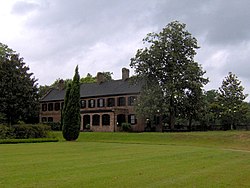Middleton Place | |
 The house museum, initially a guest wing | |
| Nearest city | Summerville, South Carolina - Charleston, South Carolina |
|---|---|
| Coordinates | 32°53′59″N 80°08′12″W / 32.89982°N 80.13654°W |
| Area | 110 acres (45 ha) |
| Built | c.1738—1755[1] |
| Architectural style | Colonial |
| NRHP reference No. | 71000770 |
| Significant dates | |
| Added to NRHP | May 6, 1971[2] |
| Designated NHLD | November 11, 1971[3] |
Middleton Place is a plantation in Dorchester County, along the banks of the Ashley River west of the Ashley and about 15 miles (24 km) northwest of downtown Charleston, in the U.S. state of South Carolina. Built in several phases during the 18th and 19th centuries, the plantation was the primary residence of several generations of the Middleton family, many of whom played prominent roles in the colonial and antebellum history of South Carolina. The plantation, now a National Historic Landmark District, is used as a museum,[1] and is home to the oldest landscaped gardens in the United States.[4][5]
John Williams, an early South Carolina planter, probably began building Middleton Place in the late 1730s. His son-in-law Henry Middleton (1717–1784), who later served as President of the First Continental Congress, completed the house's main section and its north and south flankers, and began work on the elaborate gardens. Middleton's son, Founding Father Arthur Middleton (1742–1787), a signer of the Declaration of Independence, was born at Middleton Place, and lived at the plantation during the last years of his life. Arthur Middleton's son and grandson, Henry Middleton (1770—1846) and Williams Middleton (1809–1883), oversaw Middleton Place's transition from a country residence to a more active rice plantation. In 1865, toward the end of the American Civil War, Union soldiers burned most of the house, leaving only the south wing and gutted walls of the north wing and main house. The 1886 Charleston earthquake toppled the walls of the main house and north wing.[1]
The restoration of Middleton Place began in 1916 when Middleton descendant John Julius Pringle Smith (1887–1969) and his wife Heningham began several decades' work of meticulously rebuilding the plantation's gardens. They had New York architect Bancel LaFarge design a stableyard complex of barn, stable, work buildings, and cottages; the buildings were constructed of brick salvaged from the ruined main house. In the early 1970s, approximately 110 acres (45 ha) of the 7,000-acre (2,800 ha) plantation—including the south flanker, the gardens, and several outbuildings—were placed on the National Register of Historic Places. During the same period the Middleton descendants transferred ownership of the historic district to the non-profit Middleton Place Foundation, which presently maintains the site.[6]
- ^ a b c Charles Snell, National Register of Historic Places Nomination Form for Middelton Place, 14 June 1971. Retrieved: 4 August 2009.
- ^ "National Register Information System". National Register of Historic Places. National Park Service. January 23, 2007.
- ^ "Middleton Place". National Historic Landmark summary listing. National Park Service. Archived from the original on June 6, 2011. Retrieved March 17, 2008.
- ^ Ashley Scenic River Advisory Council, Ashley Scenic River Management Plan Archived 2009-08-19 at the Wayback Machine, Report 25 (January 2003), p. 40. Retrieved: 4 August 2009.
- ^ "Middleton Place" (pdf). Photographs. National Park Service. Retrieved May 26, 2012.
- ^ Middleton Place Foundation, Middleton Family History Archived 2011-01-10 at the Wayback Machine. Retrieved: 4 August 2009.


